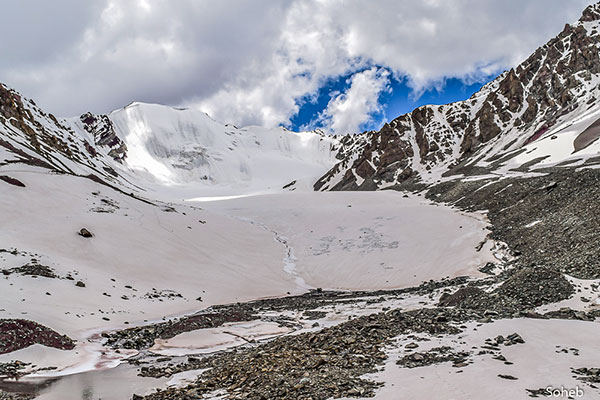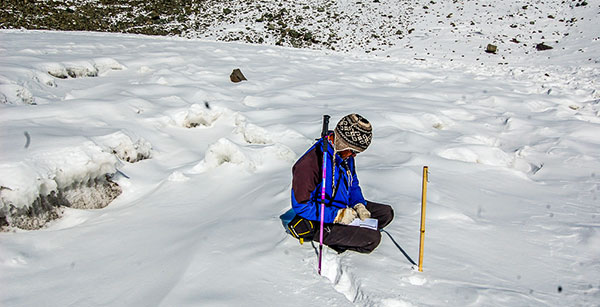Observations from Stok glacier

Growing up in Leh, I have always been fascinated by glaciers and snow. As a child, I did not think of issues such as water resources and availability for drinking and irrigation. In the cropping season, we used to source water from the main stream in Leh town. There was sufficient water for everyone due to the presence of well-maintained dZings (reservoirs) in upper Leh, efficient traditional water management systems, and active Chhurpons (water managers). The stream has almost dried up now. Areas that I remember as being lush green with wheat, barley and potato fields are now either barren or have been built over. We used to source our drinking water from a community tap located a kilometre away. In the winter, I remember the difficulties we faced in bringing drinking water home.
Right up till I finished my bachelor’s degree, I remained unaware of that fact that a discipline like cryosphere studies existed that was dedicated to the study of glaciers and snow. With constant support from my family, I managed to get admission to Jawaharlal Nehru University in New Delhi, which remains one of India’s top universities.
It was here that I finally got an opportunity to study glaciers and water resources in Ladakh. Now as I see Ladakh from the perspective of an earth and environmental scientist, I see immense potential for research and intervention especially in the fields of cryosphere, ground and surface water hydrology, wetlands, etc. I am currently pursuing my doctorate on glaciers and water resources in Ladakh and intend to continue working on Ladakh’s cryosphere, water resources and its societal impacts.
I have come to realise how important glaciers are as essential freshwater reserves for inhabitants of high altitude regions as well as lowland plains. Ladakh is a heavily-glaciated region in India and is home to nearly 5,000 glaciers, which accounts for about 50% of all glaciers in the country and covers an area of about 3,200 sq km. It is very difficult to study all the glaciers directly. Researchers are forced to use remote sensing technology, mathematical modelling and indirect techniques to study glacial systems on a larger extent. Such studies require ground-based data or ground-truthing for calibration and validation.

One such field-based measurement is currently being carried out by us in Leh. We are a team of glaciologists from Jawaharlal Nehru University, New Delhi led by Prof. AL. Ramanathan. We recently published the findings of our research in the Journal of Glaciology. Our research focuses on the Stok catchment in Leh district and has been underway since 2014 and continues. The research focuses on studying the health of the glacier by measuring glacier mass balance, water resources, and associated changes in the past, present and near future. Mass balance quantifies gain/loss of ice or water from a glacier each year.
The data we have collected so far suggests that glaciers around Leh are losing mass at a rate of 0.4 metres water equivalent per year or mw.e. a-1, which is similar to other Himalayan glaciers whose average mass balance rate is around -0.5 m w.e. a-1 per year. Our data includes measurements over five years and a historical analysis of three periods between 1978 and 2019. We found that the glacier was healthy in the period from 1978 to 1989 due to abundant precipitation. In this period, the glacier gained and lost mass in almost equal amount,which ensured that it remained relatively stable. However, in the decade from 1998 to 2009 the glacier suffered severe mass loss due to comparatively little precipitation and drought conditions. In the present decade from 2011 to 2019, the glacier has continued losing mass at a moderate rate.
The mass that glaciers lose through melting in summer are mainly offset by accumulation in the winter months. This winter precipitation is very significant for the health of a glacier and Stok is no exception. We have estimated that about 27% of excess precipitation is required to compensate for the glacial mass loss due to a 1 degree Celsius rise in temperature.
According to our research, the average mass balance for the last five hydrological years was 0.4m w.e. per year. This means that 0.4 m or 40 cm water equivalent of ice each year has been lost from the surface of Stok glacier. A lot of these numbers seem rather abstract till they are put into context to understand them in everyday terms. For instance, the figure mentioned above is equivalent to Stok glacier losing around 30,000 water tankers of 10,000 litres capacity each year since 2014.Similarly, the amount of water that Stok glacier loses in one year is enough to support Stok village for around 10 years.Finally, the volume of water that Stok glacier holds is sufficient to support the entire population of Ladakh region for about five years. Here we have assumed water consumption at the rate of 60 litres per person per day, using the 2011 census figures and excluding irrigation needs.
This gives us an idea of the amount of freshwater reserves that we have in Ladakh as Stok glacier does not represent even one percent of total glacier volume in the region. Though, we cannot harvest the entire meltwater from these glaciers for reasons ranging from topography, remoteness, lack of technology etc.,we can optimise the manner in which we use water. The simplest way is to rejuvenate and increase the capacity of traditional water management systems, while also making the best use of available water. There have been some innovations in water management techniques including artificial glaciers, ice stupas etc, whose performance need to be critically evaluated in relation to the resources they require. The successful ones must be encouraged and replicated.
Climate change and global warming is real and happening. It has observable effects around the globe and Ladakh is no exception. Glaciers in Ladakh are shrinking, temperature is rising, less snow and more rain is happening etc. These effects are due to a global phenomenon and cannot be stopped or reduced on a regional level. Instead we can educate the people to reduce our individual, societal and regional carbon footprint. In addition, we must also prioritise climate change resilient systems and adaptation strategies to mitigate the impacts of climate change.Together, we can make a significant contribution to the scientific community and serve the people of Ladakh and humanity at large.
Photographs and text by Mohd Soheb
Mohd Soheb is a Glaciologist at Jawaharlal Nehru University, New Delhi, India

Congratulations۔ informative and interesting article well done need of the time we (Ladakh) may be without water after fifty years۔ The traditional water management system (Chorpone) need further study and must build their capacity to manage water properly as I think we have this system in every village۔
It sounds like a scary scene, but i am curious to know the total area of Stok glacier that is still under the cover of ice. Would you also let us know how long do we have before it disappears completely.
Thank you for your comment.
Stok glacier is quite small (0.74 km sq in 2018) like majority (~75%) of the glaciers of Ladakh. For more information you can read Soheb et al. 2020.
Prof. Marcus Nusser and Dr. Susanne Schmidt have done very extensive work in Ladakh on a larger extent. You can also look for their many publications.
About future projections of the galciers, we are yet to finish our analysis on it. These projections require large and high resolution dataset as well as extensive field work to get a good result (or projection) with certain degree of uncertainty. For now we do not have much info on how long do we have before it disappears.
Congratulations.
Thanks for making it simple to understand.
Good luck with your future endeavours.
I really enjoyed reading this article. An elegant and interesting piece ka Soheb.
Many congratulations.